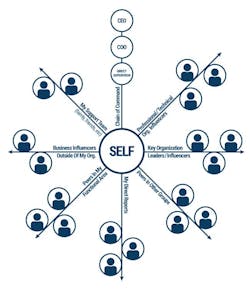Engineering Your Career, Part 4: Networking and Being Mentored
What does career success mean to you? For some, it is being highly compensated and able to comfortably take care of yourself and family. For others, it means power and control. It could also mean continuing the legacy of a family business.
Many engineers and technical professionals define success as working on challenging projects and creating technical innovations or being considered a technical expert. You may have an entrepreneurial mindset, so success could be building a new business or service line. Or it may simply mean you have found fulfillment in your work, and you are happy.
As you look for ways to advance your career, understanding your drivers and motivation is critical. And be aware that these can change over the course of a 40-year career. But if you can picture what success looks like, you have taken the first step toward a successful career.
In the early stages of your career, you should seek out those in your firm or organization who are effective based on your definition of success.
In the early stages of your career, you should seek out those in your firm or organization who are effective based on your definition of success. Once you identify these individuals, seek out opportunities to work with them. Try to position yourself so you can watch them work, see how they organize their days, and learn as much from them as you can. If working directly for these individuals is not possible, maybe you can volunteer for a committee or team project that lets you to interact with them. If nothing else, ask them to be your mentor. Most of these people are eager to mentor and develop younger engineers.
In the early stages of your career, watching and learning is key. Soak up the good you see and take note of the things you don’t like. No one is perfect and everyone has their own style. Watch others and learn which style works best for you.
As your career progresses and you begin mastering the technical aspects of your work, consider building your network. For most, advancement comes through the support of many others, and you will need them to back you along the way. One useful tool for this is a network diagram. It can help in growing your support team. The diagram should contain people you interact with at work, including your supervisor, those in key leadership positions and your peers across the organization. It should also contain personal and family friends who are important to you.
Once you have the diagram roughed out, look at relationships that need strengthening. Where do you need to invest more time? Are there people in the diagram you don’t know as well as you should? For each person, consider what you know about them and how they like to get information prior to meetings or discussions. Keep a copy of the diagram and a page for each key person at work. Make notes of what you learn about your contacts and how best to communicate with them. For engineers, this may all sound too touchy-feely, but organizational politics is all about relationships, and healthy relationships are crucial to success.
Another aspect of career growth is self-awareness and being honest about your strengths and weaknesses. Several tools can help identify blind spots, including 360 reviews and profile assessments. It is always helpful to invest in your strengths while also understanding your weaknesses. Learning about your weaknesses and what may be holding you back lets you focus on one or two key improvement areas. But it is equally important to find ways to leverage your strengths. These strengths are the assets you bring to the table, so invest in them to reach your career goals.
Taking opportunities offered to you shows a commitment to the organization.
If you take the steps discussed so far and are intentional about your career, you will have opportunities. Some of them will clearly be a great fit and easy for you to assess. Others may not seem to be a good fit or may look like a lateral move. But evaluate each opportunity carefully and find a way to say yes. That doesn’t mean you can never say no, but you should avoid turning down opportunities without carefully evaluating them or offering suggestions for modifications that might make your answer positive.
Sometimes opportunities look like lateral moves, but consider them as improving your chances for advancement. A move within the organization may let you learn different segments of the business and prepare you for a promotion. Taking opportunities offered to you shows a commitment to the organization. At the same time, turning down a move that isn’t right for you (or your family) can be a positive, so don’t mistake this advice. But look at them from all angles and seek advice from a mentor or friend before turning them down. Careful consideration and clear articulation of why you are saying no is important and can help pave the way for future openings.
So, what risk are you willing to make for your future? Do you have the vision to see that a step sideways—or maybe even backward, but in a new location or service line—will provide the experience for driving your career forward? Do you have the network and relationships needed for successfully navigating these and other important life decisions that will come your way? Now is the time to reflect on these questions and chart your path to career success.
Tricia Hatley, P.E., is the immediate past president of the National Society of Professional Engineers.
This is the last part of a four-part series on how engineers must adapt in these changing times. Part 1 covers the challenges facing today’s engineers, Part II covers PE licensing and Part III covers personal and professional development.

